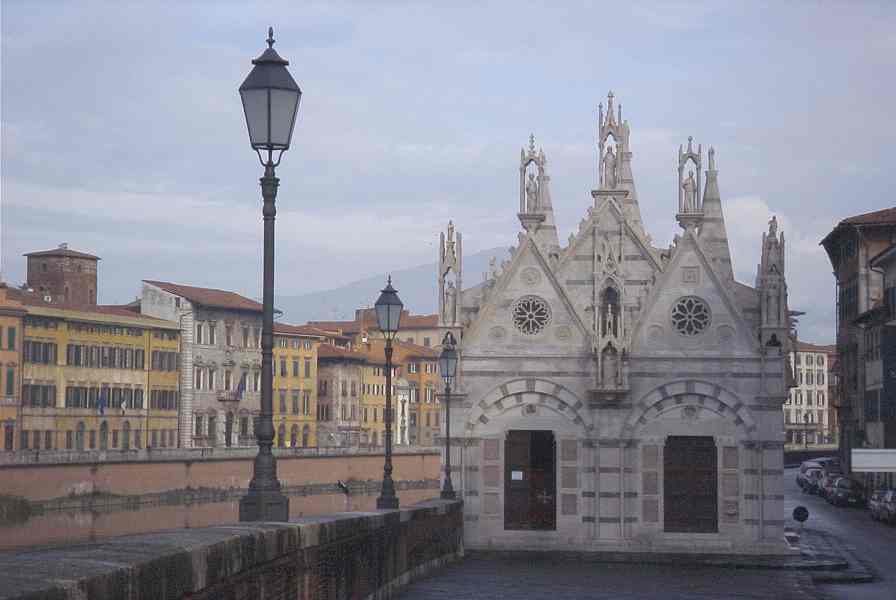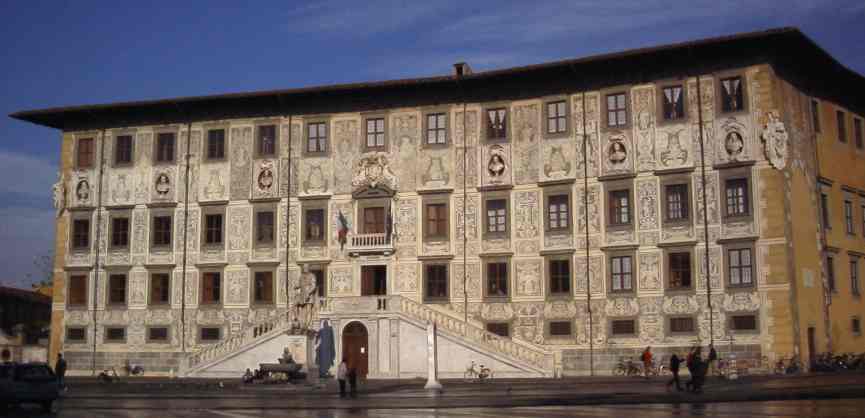

Pisa is a wonderful place. Beautiful but with a calmness about it, perhaps because cars do not seem to be incessantly rushing about, "sharing" the narrow streets with pedestrians which is often the case in places like Florence and especially Rome. After lunch we walked around and saw a few of the sights.
Like Florence, Pisa is divided by the Arno. At top is a typical street view of the houses that crush against each other on the northern shore of this very quiet river (left side). On the right stands Santa Maria della Spina, another Romanesque-Gothic jewel complete with pinnacles, spires, two tiny rose windows, statues (at least copies) in niches from the Pisano school, etc. Inside it is an empty (except for the ticket collector, of course) rectangular room lighted divided by some wooden arches. It was once supposed to have held one of the thorns from Christ's crown -- the "Spina."
The church was built in 1230 on the Arno riverbed where it frequently flooded. In 1871 it was completely disassembled and rebuilt stone-by-stone higher up the bank.
Inside is a statue of Madonna del Latte (maybe called St. Starbucks?) by Nino Pisano.
We walked by several other guide book sites which were, unfortunately, closed including the botanical gardens attached to the University of Pisa, one of the oldest (1343) institutions of higher education in the western world and still highly regarded.
Eventually we came to the heart of the medieval town, (and the Roman town as well for here the ancient forum stood), the Piazza Dei Cavalieri. Most of the buildings facing the square were designed by Giorgio Vasari, the Florentine architect (Ufizzi gallery) and biographer of the Renaissance after the Medici conquered all of Tuscany and ended Republics like Pisa. The most striking building is the Palazzo della Carovana pictured below with a 1596 Medici statue in front.

The tatoos on the building are called sgraffiti -- the Italian word for scratched as a dark layer is covered by a lighter one and then artistically scratched away.
The picture is not distorted; this façade curves. The upper niches hold the statues of the six Medici grand dukes of Tuscany.
As November's early evening darkness began to fall, we headed back to Viareggio on the sea. We drove right down the main beach drag during Passegiotto -- the evening parade with every Italian under 30 walking, honking, or that thing they call "driving." A half hour later we found a parking spot. However, our second great dinner (in the same Tuscan restaurant we visited the night before) soon restored our love for this seaside resort.
The next morning we were off to the town of Lucca for our last stop of the trip. Please join us by clicking here.
Where do you want to go today? Here's a few choices:
